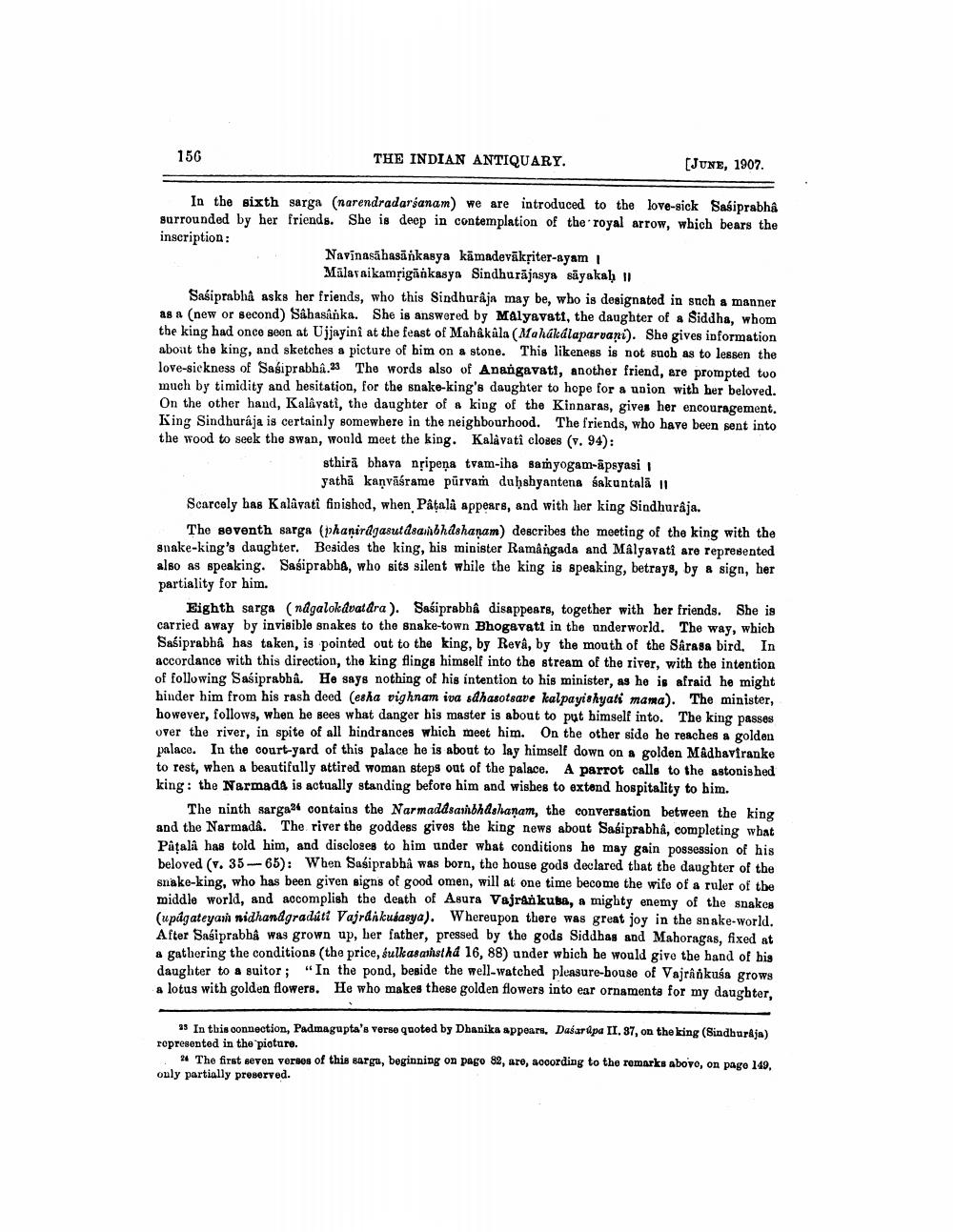________________
156
THE INDIAN ANTIQUARY.
[JUNE, 1907.
In the sixth sarga narendradarśanam) we are introduced to the love-sick Sasiprabha surrounded by her friends. She is deep in contemplation of the royal arrow, which bears the inscription:
Navinasähasänkasya kāmadevākriter-ayam
Māla aikampigahkasya Sindhurājnsya siyakah 11 Saśiprabha asks her friends, who this Sindhurâja may be, who is designated in such a manner as a (new or second) Sahasanka. She is answered by Malyavati, the daughter of a Siddha, whom the king had onco soon at Ujjayini at the feast of Mahakala (Maháldlaparvani). She gives information about the king, and sketches a picture of him on a stone. This likeness is not such as to lessen the love-sickness of Sasiprabhâ.23 The words also of Anangavati, another friend, are prompted too much by timidity and hesitation, for the snake-king's daughter to hope for a union with her beloved. On the other hand, Kalâvati, the daughter of a king of the Kinnaras, gives her encouragement. King Sindhurája is certainly somewhere in the neighbourhood. The friends, who have been sent into the wood to seek the swan, would meet the king. Kalâvati closes (v. 94):
sthira bhava nripena tvam-iha saryogam-apsyasi
yathā kanvāárame pūrvañ duhshyantena sakuntala 11 Scarcely has Kalâvati finished, when Pâtalà appears, and with her king Sindhuraja.
The seventh sarga (phanirdgasutdeanbhdshanam) describes the meeting of the king with the snake-king's daughter. Besides the king, his minister Ramångada and Mályavatî are represented also as speaking. Sasiprabba, who sits silent while the king is speaking, betrays, by & sign, her partiality for him.
Eighth sarga (nagalokavatdra). Saśiprabhâ disappears, together with her friends. She is carried away by invisible snakes to the snake-town Bhogavati in the anderworld. The way, which Sasiprabba has taken, is pointed out to the king, by Revå, by the mouth of the Sarasa bird. In accordance with this direction, the king flings himself into the stream of the river, with the intention of following Sasiprabba. He says nothing of his intention to his minister, as he is afraid he might hinder him from his rash deed (esha vighnam iva sdhasoteave kalpayishyati mama). The minister, however, follows, when he sees what danger bis master is about to put himself into. The king passes over the river, in spite of all hindrances which meet him. On the other side he reaches a golden palace. In the court-yard of this palace he is about to lay himself down on a golden Madhaviranke to rest, when a beautifully attired woman steps out of the palace. A parrot calls to the astonished king: the Narmada is actually standing before him and wishes to extend hospitality to him.
The ninth sargai contains the Narmaddsanbhashanam, the conversation between the king and the Narmada. The river the goddess gives the king news about Sasiprabha, completing what Patala has told him, and discloses to him under what conditions he may gain possession of his beloved (v. 35-65): When Sasiprabha was born, the house gods declared that the daughter of the snake-king, who has been given signs of good omen, will at one time become the wife of a ruler of the middle world, and accomplish the death of Asura Vajrankuba, a mighty enemy of the snakcs (upágateyani nidhandgradütt Vajránkusasya). Whereupon there was great joy in the snake-world. After Saśiprabha was grown up, her father, pressed by the gods Siddhas and Mahoragas, fixed at a gathering the conditions (the price, sulkasashstha 16, 88) under which he would give the band of his daughter to a suitor; "In the pond, beside the well-watched pleasure-bouse of Vajra okusa grows a lotus with golden flowers. He who makes these golden flowers into ear ornaments for my daughter,
* In this connection, Padmagupta's verso quoted by Dhanika appears. Dasardpa II. 37, on the king (Sindhuraja) ropresented in the picture.
# The first seven vertos of this sarga, beginning on page 82, are, according to the remarks abovo, on pago 149, ouly partially preserved.




